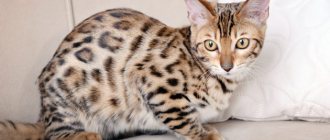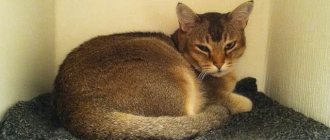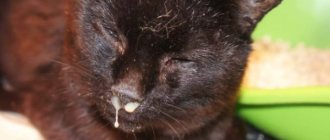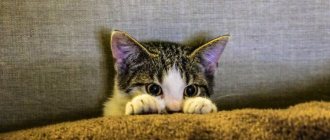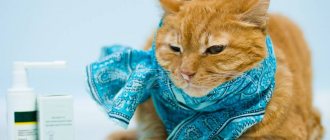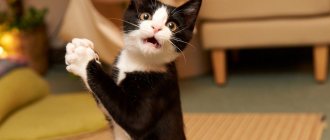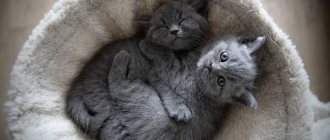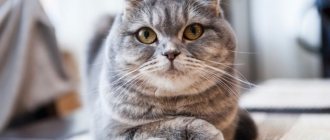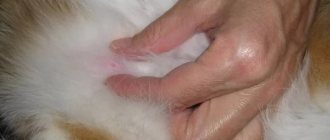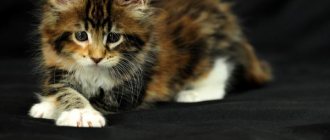In the last century, breeders set out to create a cat similar to their forest counterparts. They wanted to get a pet with the same color, but with a softer and more flexible character. This is how Bengals appeared, which are also called miniature leopards. This breed has a different temperament than other domestic cats. Anyone who decides to buy such a friend needs to know how to care for a Bengal kitten and raise it correctly.
How to care for a Bengal kitten?
Bengal cat standards
Genetics links the breed to the Asian leopard
The breed originates from the United States of America. A wild Bengal kitten rescued from poachers ended up in the hands of a breeder. Over the decades it has been crossed with various pets. Thus a new stable breed emerged. Since the late 90s she has taken part in various exhibitions.
Table 1. Bengal cat according to TICA
| Part of the body | Indicators |
| Weight | 4–8 kg |
| Body | Muscular, oblong, medium to large in size. The limbs are medium-long, the front pair is slightly shorter. The paws are clenched into round fists. The tail is also of medium length, quite thick, slightly tapering and rounded at the end. The skeleton is strong, devoid of subtlety. |
| Head | Wide wedge-shaped, rounded, the greater the difference with domestic breeds, the better. The jaw area is massive. |
| Ears | Small in height, wide at the bottom, rounded at the tips. The presence of tassels is not recommended. |
| Eyes | Oval, almost round, large, but not too big. Set wide and slightly oblique. The color of the iris is more welcome, and it does not depend on color (not counting links points). |
| Nose | Wide, large. The lobe is slightly upturned. The forehead meets the nose without a pronounced bend. The bridge of the nose is located just above the eye sockets. |
| Muzzle | Wide, the whisker pads stand out and have a slight pinch at the transition to the muzzle. The cheekbones are high and expressive. |
| Coat | The length of the hairs is short or medium, in kittens it is a little longer. It looks rich and shines (glitter effect), believed to be due to the voids in each fiber. The hairs lie tightly to the body. |
It is sometimes claimed that Bengal cats are hypoallergenic. But this is not entirely true. In fact, they simply shed less than many other breeds.
Less fur makes it easier for people to tolerate the presence of these cats in the house.
Bengal cat in all its glory
Color
The coat color of high-quality Bengals is contrasting and bright. The belly is lighter in color, with noticeable spots.
The final color is acquired only by 16 months. The photo shows a Bengal cat with a brown tabby kitten
The color of the head, typical of a tabby, is important. The eye sockets, the nasal mirror should be outlined, there should be a letter M on the forehead, and dark stripes on the cheeks. According to the standard, contrasting rings or rosettes are placed on the tail, and the limbs are “decorated” with bracelets. One of the most important requirements for coloring is the horizontal placement of spots and stripes, while usually it is vertical.
Absence of spots on the belly is considered a serious defect
The patterns characteristic of the breed are spots and stripes. The spots can be of any design - for example, bagels, but with clear edges. They must be formed by two or more colors. Marble colors, which are formed from intertwining color ribbons, are also recognized as standards.
There are two types of tabby colors recognized: brown and silver. But there are also snow bengals, which are divided into colorpoint, sepia, and mink. Blue cats are also considered standard; their fur is silver; the contrast here is somewhat less pronounced.
Bengal cat tabby color - silver
There should be a letter M on the forehead
Cleaning the eyes of a Bengal cat
Similar to the process of cleaning your cat's ears, the process of cleaning your cat's eyes makes caring for your Bengal cat similar to general cat care. For this you will need one or two more cotton balls.
Simply dampen a cotton swab(s) and gently dab the area around your cat's eyes. Since the main goal is simply to remove dirt from around your cat's eyes, be careful not to get your cat's eyes wet during this process. Your cat will definitely not be happy, and any subsequent attempt to wash her eyes is unlikely to be successful.
Bengal behavior
Character depends on the level of development and generation. Generations no lower than F4 are recommended for home keeping. These are softer, more flexible animals than their predecessors.
A kitten is not considered a real Bengal if its generation is below the fourth. It should also be noted that in the first three generations there are many sterile males.
Bengal cats are often compared to dogs due to their characteristic habits. Moreover, they easily get along with this type of animal and even love the same toys and fun, and love walks. Bengals are easy to train. Another characteristic “dog” trait is that Bengals choose one owner, to whom they are devoted under any circumstances.
Bengals are walked on a leash like dogs.
Despite their “predatory” origin, they find joy in communicating with other inhabitants of the house, except for rodents and small birds. By the way, they love to hunt for the latter and are successful in this.
These cats attract the owner's attention in an interesting way by hiding his things. They steal anything - from jewelry to paper bills. The priority is children's toys, stationery, and hair care accessories. From their wild ancestors, Bengals still have a love of water treatments. You cannot give them access to the aquarium, since we are talking about natural fishermen. Bengals love human company. They often watch their owner for a long time - for example, when he is taking a bath, and when the mood strikes, they keep him company.
Bengal kittens love to splash in the water
Mini-leopards are very active, they explore every corner of the house, and when the opportunity arises, they climb into every crevice. They need attention and love to play. They always need more and more new toys, and of an intellectual direction.
Representatives of the breed are real climbers. This quality was passed on to them from their ancestors. When taking such a pet, you need to take care of reliable protection against falls from a height, especially in high-rise buildings.
Bengals bite everything that gets in their way, including their owners and furniture. To satisfy this instinct, special toys will be required, otherwise not only the furniture is at risk, but also the skin of the inhabitants of the house.
Claw pads for cats
This is one of the most "talkative" breeds. With their voice they express their needs and desires. The range of sounds they produce is quite wide - from growls to gentle meows. And their purring can be heard even from the next room.
Video - How a Bengal cat “talks”
How to bathe a Bengal cat
These four-legged animals have absolutely no problems with bathing, as they love water. You can simply place a bowl of water in the bathroom and watch as your pet has fun splashing around in the water.
In addition to playing with water, this cat must be thoroughly washed, like any other animal. To do this, purchase a special shampoo for smooth-haired cats at the pet store. In addition to water treatments, Bengals should be combed with a special brush or glove.
Owners of these amazing cats describe them as affectionate, obedient and cheerful pets. With proper maintenance and upbringing, it is rare to find an aggressive Bengal.
Basically, they delight their owners for many years and become true friends to all family members. These domestic predators really can love and do it with all their big cat hearts.
Feeding a Bengal cat
Feeding this type of cat often causes difficulties due to the sensitivity of the digestive system, which is a feature of the breed.
Economy class products are contraindicated for Bengal cats. Such food worsens the health of the animal. Another feature of the breed is that its representatives have difficulty with changing food.
Bengal cat at lunch
Kitty
Young individuals under the age of 9 months are especially sensitive to nutrition. For the first month of life, the baby should eat only mother's milk, with which temporary immunity is transmitted to him. If a kitten at this age was separated from its mother for some reason, then special suspensions will be the best choice for it. Cow's milk should not be given, it is too heavy food. Feeding is carried out at least 6 times a day.
The best food is mother's milk
At 8 weeks, complementary foods are introduced in addition to milk, which should still make up at least half of the diet. The frequency of feedings is reduced to 6 times a day. The following products are acceptable:
- meat - boiled (preferably) or raw, pre-frozen for at least two days;
- liquid porridge from rice, oatmeal, semolina with the addition of meat in a ratio of 1 to 1;
- low-fat fermented milk products.
It is allowed to include soft pates in the diet. “Children’s” lines are offered by Royal Canin, Pro Plan. Crackers are not allowed at this age. As a last resort, they are offered soaked in water.
Royal Canin pate for kittens
By the fourth month of life, kittens completely refuse breast milk, the fermented milk group is reduced to 20%. Meat products should make up 60% of the diet. The rest is porridge and boiled vegetables (raw carrots, asparagus, cauliflower).
Bengal kitten eating
Adult cats
The feeding frequency for healthy adults is 2 times a day. If preference is given to dry food, then it should be products from the premium and super-premium segment. These are brands such as:
WildCat food line for cats
Carnilove line of food for cats
Orijen dry food
In the diet of an adult cat, lean meat should account for at least 70%. If the product is given raw, it is first frozen to destroy the parasite larvae. The meat is offered cut into pieces.
The main food of Bengals is lean meat.
The menu also includes:
- offal;
- chicken necks, especially during the period of teeth change;
- frozen fish fillet (once every 2–4 weeks);
- raw quail eggs (once every 7 days);
- vegetables - pumpkin, zucchini, carrots, spinach;
- cereals - buckwheat, rice, egg in the form of porridge, as well as sprouted wheat grains;
- cottage cheese 0% fat.
Bengal cats prefer fresh food
Clicker training a Bengal cat
One way to teach a Bengal cat to do tricks is to use a clicker in training. If you decide to use this method in training, you can teach a number of techniques. Starting clicker training is simple and does not require any special skills.
- Associate the clicker with food. The first thing you need to do to clicker train your Bengal cat is to get them to associate the sound of the click with a treat. To do this, sit down with your cat and be ready with a handful of treats. Start with a clicker. At the same time, give your cat a treat. Do this at least 10 times and your cat will begin to make a connection between the sound of the clicker and the food. To test this, try pressing and then wait a second before giving your cat a treat. The cat should respond to the sound of the click by looking eagerly at your hand for a treat or even extending its paw to receive a treat.
- Add a teaser stick. Using a motivational stick will help you teach your Bengal cat to do tricks more easily, and the longer reach will also make it easier for you. Start by adding a treat or canned cat food to the end of a motivation stick. Hold the stick approximately 20-30 cm from your Bengal. Once she touches the stick to explore the treat, press the button and let your cat enjoy her snack. Then move the stick away from them, add more treats or cat food, and repeat several times. Next, start holding the stick away from the cat so that she actually stands up and moves towards the stick. Keep pressing as your cat touches it with her nose and allow her to lick the treat off the end of the stick. Soon, the cat will be more willing to follow the motivating stick everywhere. To start training your Bengal cat further, move the stick to the sofa or chair so that the cat will jump up to get to the treat. As always, be sure to reward her with a click and then a treat as soon as she touches the motivation stick. Now that your Bengal cat has completed clicker training, she is ready to learn lots of tricks!
Bengal care
You need to prepare for the arrival of a Bengal kitten. The standard set of items includes:
- tray - preferably with high sides so that the contents do not fall outside the container;
- filler - the one to which the animal is already accustomed;
- utensils for eating and drinking - ceramic or metal are better, since microcracks in aging plastic can harbor microbes;
- a do-it-yourself pet bed or house (these cats are territorial and need their own shelter);
- a play complex with playgrounds almost under the ceiling, since Bengals love heights;
- several toys - balls, tunnels, laces, bells, etc., there are never too many of them.
House for a Bengal cat
How to cheer up a cat if he's bored? You can read more about ways to determine the cause of such a mood and techniques that will help improve your pet’s mood in the article “How to Cheer a Cat” on our website. In addition, you will receive recommendations on the use of modern gaming gadgets in your cat’s daily life, and you will also be able to decide on the choice of toys and treats for your bored pet.
Bengals are distinguished by exceptional cleanliness. Therefore, the tray should always be clean. If the used filler is not removed in time, the owner may be in for an unpleasant surprise - a puddle in the wrong place.
To prevent the wool from losing its magical shine, it is cared for accordingly. Weekly brushing is a must. The brush removes dead hair and helps distribute sebum evenly over the entire surface of the body.
A cramped apartment is not suitable for a Bengal. This is an active cat that needs ample space to play, run, and climb. It's good if you have access to the street.
Running wheel for cats - additional physical activity
In the material “Running Wheel for Cats” on our website you will find out the benefits of a running wheel for a cat. How to get her used to the running wheel. In addition, the article talks about what types of running wheels there are, what design to choose in the store, and also how to make a running wheel for a cat with your own hands.
To keep your teeth healthy, cleaning with special brushes and toothpastes is necessary. If the animal resists, sometimes instead of the procedure they offer to chew dry jerky.
Many Bengals, despite their craving for cleanliness, bathe in toilets. Therefore, this piece of plumbing must always be covered with a lid.
Video “What you need to know about the Bengal cat”
From this video you will learn about how the Bengal cat breed appeared, how to care for and feed it.
Recommended Posts
Standard height and weight of the Cane Corso breed by month
Weight of a puppy and an adult Labrador by month
Description and content of the hunting border terrier
Weight and height of a German Shepherd puppy by month
Description and care of the highly intelligent Border Collie breed
Description of forms and features of treatment of enteritis in cats
Training and education of a Bengal cat
Everything fragile and valuable is removed from accessible places. Any thing that comes under the paws turns into fun. Therefore, the kitten is provided with an arsenal of toys. Animals prefer everything that rustles and buzzes.
Bengal needs his owner to play with him. Suitable fun is hide and seek around the corner. You need to talk to the cat. In communication, commands are used that correct the pet’s action - the words “no”, “fu” or “well done” if the cat did well, etc. First, in order to remember, the spoken word is accompanied by some action - for example, a pinch on the neck.
Violence is not applicable to cats. The exception is when it is necessary to urgently hold an animal or undergo a medical procedure. Screaming and swearing are unacceptable.
You can't hit a cat
If a cat plays with a prohibited object, it is stopped with a verbal prohibition or a loud clap: animals associate sharp sounds with danger. Use a water gun effectively.
Bengals are touchy and have a good memory. Even a one-time undeserved punishment will cause them to distrust their owner. Then it is difficult to establish contact.
Bengal cats have developed intelligence compared to other breeds. They easily learn the commands that dogs perform - for example, “Give me your paw.” You can learn training skills at special courses, which are often organized by felinological communities.
Bengal cat training
Tricks that the animal can master:
- bring an abandoned stick to the owner;
- jump from chair to chair like a tiger in a circus;
- walk on a pole;
- walking between the owner's legs when he takes a step;
- dance on hind legs.
A kitten is taught to use a leash from 3 months
How much does a Bengal cat cost and where can I buy it?
This breed is among the top 10 most expensive. The cost of a kitten is from 10 thousand rubles. It is better to buy a Bengal cat in nurseries, where they will provide a pedigree and other documents for the animal.
This breed is not for everyone
Although Bengals are a rather expensive breed, you can save money. For example, individuals with defects that are not recognized by the standard are cheaper, but this does not affect the appearance. Kittens in adolescence (from 4 to 6 months) also cost less. Sometimes individuals are taken out of breeding, which also makes it possible to become the owner of a Bengal for relatively little money.

